Students at an Oxford college will return this term to find an entirely new set of faces staring down on their meals in the great hall: the portraits of dead white men, dim under their cloudy varnish, have been swept away, replaced by striking black-and-white photographs of female fellows and graduates.
Their new dining companions have been installed to celebrate a shockingly recent event: the 40th anniversary of the admission of female undergraduates to Hertford, one of the formerly all-male colleges.
Hanging above the centre of the top table is a portrait of Shahnaz Ahsan, a young graduate. Until last week, the space was occupied by William Tyndale, first translator of the Bible into English. The portraits of female graduates and fellows, nominated by staff and students, include scientists Kay Davies and Alison Woollard, philosopher Lady Warnock, bankers Charlotte Hogg and Serine Najaran, QC Joanne Wicks, museum curator Xanthe Brooke and world champion rower Stephanie Cullen.
There is also Jacqui Smith, described only as a fellow and hospital trust chair: no mention of her career as Labour's former home secretary, or its ignominious end in the expenses scandal.
Each woman contributed a note about their experiences. Wicks, who studied law in 1985, wrote: "At a scholarship interview at Lincoln's Inn, one member of the 12-strong panel of elderly white men looked down his nose and asked me sarcastically whether the existence of the women's group indicated that Hertford women were an 'oppressed minority'. I told him that we were definitely a minority and that we were 'working on the oppression bit'."This year, the student intake will be roughly 50-50 men and women, though there are still more men than women among the academic staff.
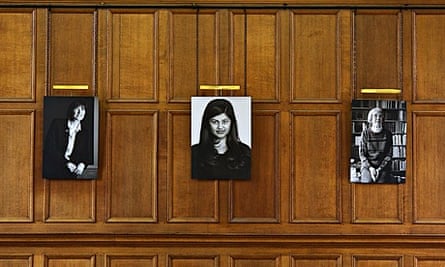
Emma Smith, an English lecturer and fellow since 1997, who curated the exhibition of photographs, all taken by Robert Taylor, said: "We haven't gone for our most famous, most successful or richest. They're not necessarily intended to be aspirational figures – they're just some individuals who have done some interesting things." It has been warmly welcomed by students, graduates and staff, though Smith did get what she describes as "a few political correctness gone mad letters".
The exhibition celebrates the fact that in 1974, when the philosopher Geoffrey Warnock was the principal, Hertford was among a small group of formerly all-male Oxford colleges that took an audacious leap into the 20th century and decided to admit women as undergraduates. By then Stephanie West, the senior figure among the portraits, magnificent in a stripy jumper against a cliff face of books, had already been on the staff as the head of classics since 1966. It took a little longer for female fellows: the critic Julia Briggs was the first, in 1978. She died of a brain tumour in 2007, and hers is the only archive photograph: "So many people mentioned her, and so fondly," Smith said.
Evelyn Waugh was an undergraduate at Hertford from 1922. "He hated it," Smith said. "It was at one of our lowest ebbs, a place of absolutely no academic distinction whatsoever and he knew it. If nobody else would take you then Hertford would." Some of his Oxford of Brideshead Revisited, a world largely untroubled by women except sporadic visiting mothers and sisters who have to be taken for tea, is set in Hertford.
It was a ground-floor room in the Hertford quad that Charles Ryder's stupendously dull cousin Jasper urges him to change: "I've seen many a man ruined through having ground-floor rooms in the front quad. People start dropping in ... Before you know where you are you've opened a free bar for all the undesirables of the college." Sebastian Flyte makes his memorable first appearance in the novel leaning in from the quad through the open window to be sick on Charles's floor. As a mere graduate Waugh never made it to the walls of the hall, but survives in a notably grumpy pencil portrait hanging in the senior common room. The room also holds what Smith regards as the only two works of art among the portraits: John Donne's is a 19th-century copy of the one in the National Portrait Gallery, but the splendid portrait of Neville Murphy is by Stanley Spencer and Warnock's is by David Hockney.
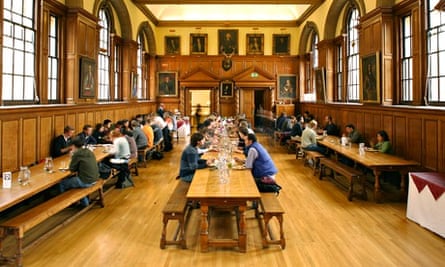
The college has a patchy history, dating back to the 13th century with a roll call including Donne, the satirist Jonathan Swift, the radical politician Charles James Fox, and the Maltese prime minister Dom Mintoff. However, the story includes repeated near bankruptcy and closure, literally reaching a new low in 1820 when most of the medieval facade collapsed into the street. Even when the broadcaster Natasha Kaplinsky – whose glamorous portrait is included – arrived to study English in 1992, she was told it was "so poor it could easily be swapped for a packet of mixed biscuits".
"That's what made this so easy," Smith said. "We have no glorious history, we're not hidebound by ancient traditions, we have none.
"Taking down all the portraits was helped by the fact that nobody felt the slightest affection for any of them, with the exception of John Donne."
The new portraits will be formally unveiled by the principal, Guardian columnist and former Observer editor in chief Will Hutton, and will remain for a year.
What happens next has not been decided, but Smith is determined that the hall will not revert to a gallery of dull portraits of anonymous men. In the case of a row of 18th-century clerics, literally anonymous: when they came down off the wall they were mostly unlabelled, and nobody had a clue about their identity. "We really don't want them back," Smith said.
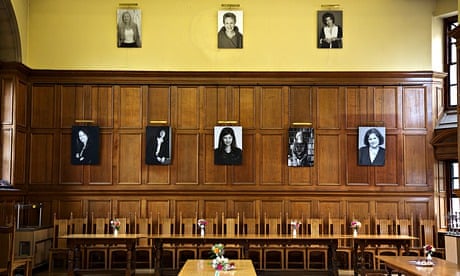
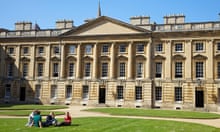

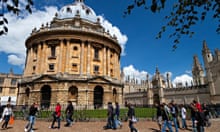
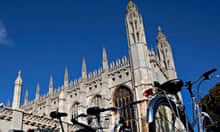
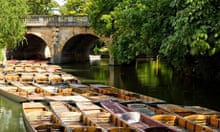
Comments (…)
Sign in or create your Guardian account to join the discussion